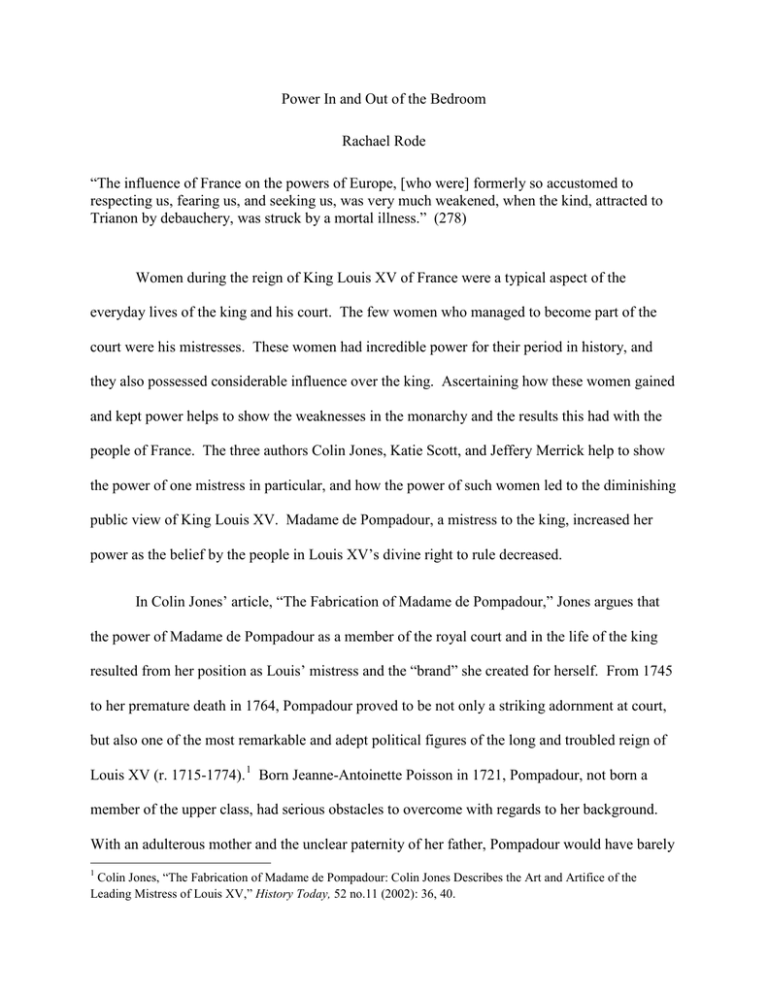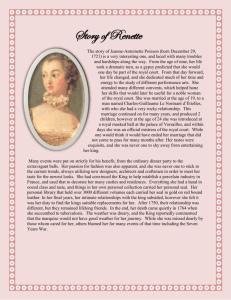Power In and Out of the Bedroom Rachael Rode
advertisement

Power In and Out of the Bedroom Rachael Rode “The influence of France on the powers of Europe, [who were] formerly so accustomed to respecting us, fearing us, and seeking us, was very much weakened, when the kind, attracted to Trianon by debauchery, was struck by a mortal illness.” (278) Women during the reign of King Louis XV of France were a typical aspect of the everyday lives of the king and his court. The few women who managed to become part of the court were his mistresses. These women had incredible power for their period in history, and they also possessed considerable influence over the king. Ascertaining how these women gained and kept power helps to show the weaknesses in the monarchy and the results this had with the people of France. The three authors Colin Jones, Katie Scott, and Jeffery Merrick help to show the power of one mistress in particular, and how the power of such women led to the diminishing public view of King Louis XV. Madame de Pompadour, a mistress to the king, increased her power as the belief by the people in Louis XV’s divine right to rule decreased. In Colin Jones’ article, “The Fabrication of Madame de Pompadour,” Jones argues that the power of Madame de Pompadour as a member of the royal court and in the life of the king resulted from her position as Louis’ mistress and the “brand” she created for herself. From 1745 to her premature death in 1764, Pompadour proved to be not only a striking adornment at court, but also one of the most remarkable and adept political figures of the long and troubled reign of Louis XV (r. 1715-1774). 1 Born Jeanne-Antoinette Poisson in 1721, Pompadour, not born a member of the upper class, had serious obstacles to overcome with regards to her background. With an adulterous mother and the unclear paternity of her father, Pompadour would have barely 1 Colin Jones, “The Fabrication of Madame de Pompadour: Colin Jones Describes the Art and Artifice of the Leading Mistress of Louis XV,” History Today, 52 no.11 (2002): 36, 40. 2 qualified to be classified as bourgeois. She managed to overcome these difficulties to marry in 1741, and shortly thereafter she met the king outside her husband’s château. After attending her first royal ball in February of 1745, Pompadour became the king’s lover, and they installed her at Versailles by March with a separation from her husband being arranged. 2 Once she officially took on the role of the king’s mistress she began her work of gaining power. Obviously her power reached beyond Louis XV’s bedroom into the realm of the royal court and included activities such as intimate confidante, governmental aide, ministerial adviser (some said effective principal minister to boot), as well as outstanding artistic patron and cultural impresario. 3 The power held by Madame de Pompadour grew so vast that many heads of state would consult her on how to do their jobs or at the very least take suggestions from her. This angered a many number of people on the court not to mention all the citizens of France who saw the poor governance of the king a direct result of his life of constant sin. Pompadour differed from the usual mistress in the fact that she eventually stopped having sex with the king. As Jones shows with quotes from admirers and the king himself, the halt was not a result of the lack of Pompadour’s beauty. She just did not choose to continue that part of the relationship with the king. However, she knew she had to appease Louis’ sexual desires in some way so she chose to bring in young beautiful women to slake his lust. 4 While providing the king with these many women, Pompadour continued to expand her power into the areas of policy, armed forces, and administration. All the while the heads of these departments were furious with her and the way Louis XV ran the government. To make sure she kept her place as mistress she began having a number of self-portraits painted in which she looked as young and striking as ever. Using social 2 Jones, “Fabrication of Pompadour,” 38. Jones, “Fabrication of Pompadour,” 36. 4 Jones, “Fabrication of Pompadour,” 40. 3 3 and political insights, Jones depicts Pompadour as a woman ahead of her time with the great amounts of power and influence she possessed. Katie Scott, like Colin Jones, speaks at great length about Madame de Pompadour; however, her argument takes a bit of a different stance. In “Framing Ambition: the Interior Politics of Madame de Pompadour,” Scott intends to depict an accurate description of the many apartments of Pompadour and how she used her architectural and decorative choices to gain and keep power with the king. Similarities to Jones exists other than just with regards of the mention of Pompadour; according to Scott, Pompadour was a preferred member at court in addition to the mention of her status as a woman of low birth. 5 Both authors also recognize the wide ranging power of the king’s mistress; however, the source of this power differs from Scott to Jones. Scott’s cultural history attributes Madame de Pompadour’s power to her love of architecture and decorating. Through the way she decorated her apartment, château, and upstairs attic, Pompadour not only sought power, but she also became a front runner among other patrons of the arts. She had a number of paintings commissioned, many of which were of her, as gifts or decorations for the king. François Boucher, Pompadour’s artist of choice, says something about her in and of itself. She had to have some sort of clout and power to have a work commissioned by such an artist. Scott argues, “The scale [and] sheer mass of the work indicates that [her] personal taste was of public consequence, that it framed a political ambition.” 6 5 Katie Scott, “Framing Ambition: The Interior Politics of Madame de Pompadour,” Art History 28, no. 2 (2005): 248-290; 256-257. 6 Scott, “Framing Ambition,” 252. 4 Without changing the architectural form of Versailles significantly, Pompadour introduced a new pathways and routes inside the palace. 7 As evident in the floor plans of the attic apartment that belonged to Pompadour, she cunningly gained access to the king through a set of stairs that were all her own. Since her room connected to his, this allowed for many an intimate meeting which resulted in the beginning of her power acquisition. Once she had the power and continued to expand it, she would be close enough for the king to come consult or confide in her whenever his fancy struck him to do so. With regards to her own apartments she was a bit freer to explore her likes and dislikes. Since the space belonged to her, she could decorate, paint, and arrange the rooms however she saw fit. The third and final author, Jeffery Merrick tells a bit of a different story but one that still relates to the power held by the mistresses of the king even though at the time of his death he enjoyed the company of someone other than Madame de Pompadour. “Louis XV’s Deathbed Apology” tells the story of the king’s final days and his last confession. The rather intriguing fact about Merrick’s story is the drastic differences from one account of what was said to another simply depending on eyewitness versus second-hand accounts and variations in political associations. He argues that the final confession of King Louis XV was gravely contested among witnesses as well as confidants of the king as a result of these previously mentioned divisions. The alleged story, according to Merrick, follows these basic principles. The king had contracted small pox, presumably from one of his many mistresses of the day. The current head 7 Scott, “Framing Ambition,” 257. 5 mistress of the day was Madame du Barry, who many people referred to as a common whore. 8 Du Barry had been providing the king with many beautiful young women to keep him satisfied, and this led to how he contracted small pox. Initially the doctors and his Abbé did not want him to worry about his condition so they did not tell him how bad he was. When the king finally realized he had smallpox, he sent Madame du Barry away to avoid any repetition of his humiliating experience in 1744. 9 He continued to worsen, and on the 7th of April 1774, the king asked for his confessor. From this moment forward nothing said by the king can be verified with any degree of certainty. Merrick acknowledges a considerable amount of differing opinions as to what the king truly said in the final confession. According to Merrick, no matter what Louis XV told La Roche-Aymon (his private confessor), no matter what the Grand Almoner actually said, people heard, thought they heard, said they heard, or wanted to hear different messages in the king’s apology. 10 In comparison to Jones and Scott, Merrick mentions the power and far reaching influence of Louis’s mistress, du Barry. The mention for Merrick differs a bit though. The political power that du Barry had had resulted in a following that had formed into a faction supporting her. For as many supporters as she had, she had just as many bitter opponents. These political divisions led to a coloring of the king’s apology. For instance, the baron de Besenval, who happened to be an ardent opponent of du Barry, included the anecdote in his narrative that the king was forced to send his mistress much farther away than Rueil before his confession would be heard. 11 Whereas, someone who supported du Barry may not have mentioned her at all and mentioned that the king apologized to 8 Jeffery Merrick, “Louis XV’s Deathbed Apology,” European History Quarterly 38, no. 2 (2008): 206. Merrick, “Deathbed Apology,” 209. 10 Merrick, “Deathbed Apology,” 214. 11 Merrick, “Deathbed Apology”, 212. 9 6 his people for letting them down. The apology of King Louis XV to his people reiterates the point that many of them felt personally wronged and let down by their king. These feelings do a great deal to explain the belief that the king had lost his divine right to rule as a resort of his lifestyle of sin and debauchery. Through the authors Colin Jones, Katie Scott, and Jeffery Merrick, a picture has been painted of the great power held by the many mistresses of Louis XV. Even though a mistress was a common occurrence in the life of royalty, kings in particular, Louis XV may have gone a step too far one time too many. The people soon began to believe the king had lost his divine right to rule and by the time of his death many of them expected more than an apology. Their lack of faith in their ruler would carry over to the reign of the next king, and would eventually lead to a complete overthrow of the government. But that is another story.






